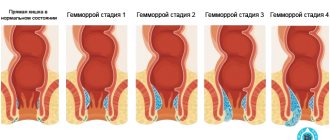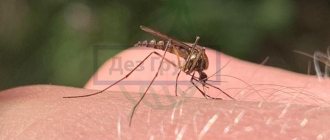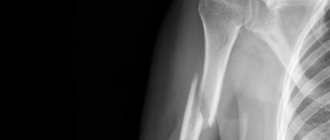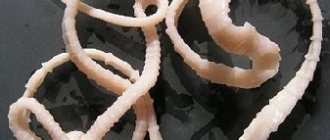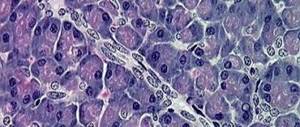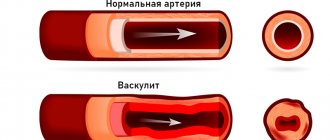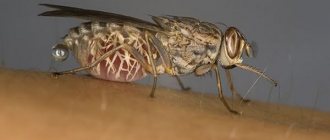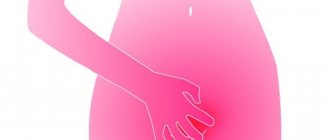How does an anal fissure appear?
The main symptom is pain, so it is difficult to ignore an anal fissure. Painful sensations can be of varying intensity, most often intensify during defecation, and gradually subside after it. The pain can be so severe that it makes you afraid to go to the toilet. Sometimes people with an anal fissure stop eating food because of this fear, hoping that this will delay the moment of defecation. This tactic often backfires.
In some situations, if you do not contact a coloproctologist for treatment for a long time, the intensity of the pain becomes so severe that it becomes painful to sit and walk. Most often this happens if an infection occurs.
There may be a feeling of “stiffness” in the anus, a foreign body in the anus.
Another equally frightening symptom is bleeding. Blood from an anal fissure is often bright red in color, may come out in drops or simply leave red marks on toilet paper. Sometimes traces of such blood can even be seen on underwear.
The appearance of blood, pain and any other unpleasant sensations in the anus should alert you. If you have the complaints noted above, you should immediately contact a specialist, since the sooner treatment is started, the faster it will be possible to get rid of the anal fissure completely.
How to treat anal fissures?
Acute cracks are usually healed using various forms of medications, that is, treated conservatively. Today, a proctologist has ointments, creams, gels and suppositories in his arsenal. They also sometimes resort to tablet medications.
Baths
Before local treatment of anal fissures, antiseptic and anti-inflammatory sitz baths are prescribed. They need to be done after defecation. The solution temperature is 30 degrees Celsius, duration is 10-15 minutes.
- A decoction of chamomile and oak bark (separately or in a ratio of 2 to 1) is used as a medicinal solution. Chamomile suppresses inflammation in tissues, facilitating healing. Oak bark has an astringent effect, drying out the crack. You can also use decoctions of calendula or yarrow.
- Less commonly, a weak solution of potassium permanganate (pale pink) is used as an antiseptic.
Ointments, creams
The ointment for cracks should contain a fatty base, not cause irritation to the skin and mucous membranes and, ideally, combine anti-inflammatory and tissue healing properties. It is administered 1-2 times a day after bowel movements and a ten-minute bath in the amount of one centimeter. The average duration of a course of treatment with ointments for an acute fissure is 7-10 days. Most drugs for cracks are also used to treat hemorrhoids (see list of all ointments for hemorrhoids).
- Ultraproct 420-500 rubles – a combination of the glucocorticoid fluocortolone and the local anesthetic cinchocaine. It has anti-inflammatory, antipruritic and analgesic effects.
- Aurobin 190-230 rubles – a combination of prednisolone (anti-inflammatory and antiallergic effect) with lidocaine hydrochloride (local anesthesia) and dexpanthenol (acceleration of healing and restoration of the skin and mucous membranes). The drug is contraindicated in pregnant women, breastfeeding women, people with bacterial or viral inflammation or intolerance to the components of the ointment.
- Dexpanthenol, Bepanten, Pantesol 70-120 rubles - ointments and creams based on pantothenic acid, which affects protein and fat metabolism and accelerates healing.
- Solcoseryl 160-180 rub. in the form of an ointment or gel, it accelerates the absorption of glucose by tissues, thereby improving tissue nutrition.
- Actovegin 100-120-180 rub. improves cellular respiration and glucose utilization, promoting tissue repair.
- Methyluracil 60-80 rub. – a medicine that combines the properties of an anabolic and anti-inflammatory agent, an immunomodulator.
- Proctosan 230-270 rub. contains bismuth subgallate, titanium dioxide, lidocaine and befexamac. Dries and heals the crack.
- Emla 1400-1600 rub – local anesthetic based on lidocaine and prilocaine. The drug is indicated for spasm of the anal sphincter against the background of a chronic fissure. May cause decreased heart rate and allergies.
- Katedzhel 120-140 rub. combines lidocaine and the antiseptic chlorhexidine. Indications are similar to emla.
- Levomekol 80-120 rub. – antibacterial chloramphenicol and methyluracil, which accelerates crack closure. The drug is indicated for chronic or inflamed fissures. It should be remembered that long-term use may be complicated by anemia and a decrease in white blood cells. Levomekol ointment is contraindicated for breastfeeding women.
- Nitroglycerin ointment 0.2% dilates blood vessels and relieves sphincter spasm. Prepared according to the recipe.
Suppositories
Suppositories are a convenient dosage form that allows the main medicinal substance to be quickly absorbed into the veins of the hemorrhoidal plexus. In addition, candles are made on the basis of cocoa butter or other neutral fat, which at the same time act as a laxative. When there is a chronic anal fissure, treatment is best done with combined agents containing painkillers and antispasmodics. Preparations in suppositories are used twice a day after bowel movements.
- Preparations with local anesthetics that relieve pain and burning: suppositories with Belladonna extract 40 rubles, Anuzol 60 rubles (belladonna, bismuth tribromophenolate, zinc sulfate)
- Anestezol (benzocaine, bismuth subgallate, menthol, zinc oxide)
- Proctosan (lidocaine hydrochloride, bismuth subgallate, titanium dioxide).
For more details on the instructions for the medications, read the article suppositories for cracks and hemorrhoids.
By making your stool softer and your bowel movements more frequent every day, you can eliminate one of the main reasons why a fissure occurs around the anus. Medicines that facilitate bowel movements are divided into the following groups.
- Emollients (vaseline and sea buckthorn oils, Norgalax). At home, for problems with the anal sphincter, counter microenemas are used 10 minutes before bowel movement (100 ml of pasteurized sunflower oil and 200 ml of boiled water at room temperature).
- Agents that increase the volume of intestinal contents: herbal based on agar or psyllium (Naturolax, Mucofalk, Fiberlex), based on cellulose (Fiberal, Fibercon).
- Polyhydric alcohols: Duphalac, Normaze, Lactulose (standard, non-irritating to the intestines), Sorbitol, Macrogol, Lactiol (see all laxatives).
Doctors immediately warn that treating anal fissures is a long process, and the patient must approach it with special responsibility. Complete recovery and absence of relapses depends on the person’s discipline, because it includes not only drug therapy, but also diet and lifestyle changes in general. Let's look at these three steps you can take to treat anal fissures.
The nutrition of patients suffering from fissures in the anal canal should be aimed at eliminating the main irritant - constipation and hard stool. It makes no sense to be treated with tablets, ointments or suppositories, when each act of defecation will again provoke tension in the anus and injure the mucous membrane.
The diet for a rectal fissure should include foods with plenty of vitamins, minerals and fiber.
The dietary table consists of recommended dishes that improve peristalsis and soften stool. Among such products are lean meat, kefir, yoghurt, vegetables and fruits; you can separately eat dry fiber, drink berry jelly and compotes. It is good to include prunes, beets, and oven-baked apples in your diet.
Compliance with the drinking regime plays an important role - water, green tea, fruit drinks and other types of liquid should be supplied to the body daily in a volume of at least one and a half liters. In the morning on an empty stomach, it is advisable to drink a glass of warm water with a spoonful of honey, and at night - a glass of fresh kefir, you can add a teaspoon of vegetable oil.
The following products need to be removed from the diet or reduced to a minimum: fast food, sandwiches (and white bread in principle), crackers and chips, alcohol, potatoes, pasta, pastries, chocolate, especially milk chocolate. Strong tea, coffee, cocoa, fatty, spicy or canned foods are also excluded.
We suggest you familiarize yourself with vascular network on the legs - how to get rid of it, causes and treatment
Patients are advised to give up a sedentary lifestyle. The list of recommendations includes visiting the pool, walking, cycling (allowed only after treatment). People holding positions that do not require activity during the day should get up every half hour or hour, do light exercises, and walk up the stairs.
All experts are of the same opinion that sports training has a positive effect on the entire body and health.
During the cold season, it is important to dress properly and cover your lower back and buttocks. During frosts, especially women, you need to wear thermal underwear or other warming clothing to prevent inflammation in the pelvis and rectum.
Particular attention should be paid to personal hygiene. After defecation, the best option is to wash the anal area with warm water or use damp toilet paper. It is better to put away traditional paper rolls until the time of recovery.
For the conservative treatment of anal fissures, drugs in various form factors are used. Most often these are suppositories, various gels, creams, ointments and balms. Let's consider effective and popular drugs.
It is suppositories that are considered the most effective way for the therapeutic treatment of any problems in the anus, including fissures. Suppositories are easy to use at home, they have a direct effect directly in the anus, and rarely have contraindications.
Rules for the use of rectal suppositories
Table 3. Candles for cracks
| Name, price | Characteristic | Mode of application |
| "Natalsid", about 500 rubles for 10 pieces | Wound-healing, anti-inflammatory and hemostatic drug based on sodium alginate (obtained from seaweed) | Twice a day for two weeks |
| “Proctosan”, about 400 rubles for 10 pieces | Has an astringent and drying effect, heals well, relieves pain due to the content of lidocaine | Once a day (at night) for 8-10 days |
| "Ultraprokt", about 650 rubles for 10 pieces | Anesthetizes, eliminates itching and burning, heals, relieves inflammation. Contains anesthetic | Twice a day for a week |
| “Posterizan”, about 400 rubles for 10 pieces | Stimulates local immunity (as it contains cells of killed E. coli), relieves itching, relieves pain, restores mucous membranes | Morning and evening after bowel movements for two to three weeks |
| Suppositories with propolis, about 200 rubles for 6 pieces | A drug with an immunostimulating, wound-healing, anti-inflammatory effect. Contraindications – allergies to bee products | Before bed for two weeks |
| Suppositories with sea buckthorn, about 130 rubles for 10 pieces | Relieves irritation, itching, softens the rectum, promotes healing | Before bed for two weeks |
| "Salofalk", about 1400 rubles for 10 pieces | Contains salicylic acid, kills bacteria, disinfects, relieves pain and burning sensation | Three times a day for 7-10 days |
| “Procto-Glivenol”, about 400 rubles for 10 pieces | Reduces pain, relieves inflammation, swelling, provokes venous outflow, stimulates healing | Before bed for two weeks |
Creams, ointments, gels
What can an anal fissure be like?
Depending on the duration of the course, the crack can be acute or chronic.
Depending on the cause of development, primary and secondary anal fissure are divided.
Depending on the location in the anal canal, the fissure can be anterior, posterior, or lateral.
The diagnosis of acute anal fissure is established if a person consults a specialist immediately after the occurrence of unusual symptoms. In most cases, an acute crack can be called a process that lasts no more than 4-6 weeks. Such a crack is a thin defect of the mucous membrane, sharply painful when touched. There are usually no other changes in the anal canal with an acute fissure.
Rice. 1 Acute posterior anal fissure
If you do not start treating an anal fissure in a timely manner, then most likely it will become chronic, however, with properly selected conservative treatment, you can do without surgical treatment.
A chronic anal fissure occurs when a patient suffers from an acute anal fissure for a long time. Constantly occurring inflammation leads to thickening of the wound edges, which makes conservative therapy unsuccessful.
We can talk about a chronic fissure when there are at least two of the following symptoms: 1) pain after defecation, lasting more than three months; 2) the presence of secondary changes; 3) increased sphincter tone.
Rice. 2 Chronic posterior anal fissure (scarred edges are identified, which indicates a long course of the disease).
Typical clinical picture
The formation of a chronic crack is associated with the lack of treatment of the pathology in its acute phase of development.
At the initial stage, a wound surface is formed on the surface of the mucosa. After 2-3 weeks, areas consisting of connective tissues form at the site of the wound formation. At this stage, the damaged area is covered with a fibrous film.
Chronic anal fissure is characterized by the formation of dense areas along the edges of the lesion. Further progression leads to the appearance of trophic changes.
As a result of progression, the formation of specific sentinel tubercles is observed. These areas are characterized by increased proliferation of modified tissues. The development of pathology subsequently leads to the appearance of rectal polyps in place of the sentinel tubercles.
Chronic anal fissure is characterized by the following symptoms:
- The appearance of pain during the act of defecation and after its completion for a long time. The intensity of discomfort is assessed as average. The patient experiences pain while sitting and walking, and very often the pain can be bothersome at night.
- The resulting spasm of the anus is less intense than in the acute form of the pathology.
- Slight bleeding occurs. In the form of scarlet spots on linen or toilet paper.
- There is a development of psychological fear before the act of defecation.
- Purulent discharge from the anus may appear.
- When palpated, the presence of sentinel tubercles is revealed, which are scars at the site of cracks.
- The pathology is characterized by cyclical development in the form of remissions and exacerbations.
The healing of the chronic process takes much longer and as many scars are formed as cracks have formed. In some cases, significant scar formation is observed, leading to a significant narrowing of the rectal lumen.
If such a situation occurs, surgical intervention is required.
What may be secondary changes in chronic anal fissure?
— sentinel tubercle (shown in the photo) — skin fold (shown in the photo) — fistula (shown in the photo)
Rice. 3 Anal fissure with the formation of a fibrous polyp similar to the hypertrophic anal papilla
Rice. 4 Course of an anal fissure with the formation of a skin fold
Rice. 5 Anal fissure with the formation of a secondary fistula tract
If an anal fissure develops in a patient due to dense stools, frequent loose stools, anal sex or the use of sex toys, then it will be classified as a primary anal fissure. And if an anal fissure occurs in a patient who suffers from other diseases, such as anal cancer, cicatricial stricture of the anus, Crohn's disease, ulcerative colitis, HIV, then we will classify it as a secondary anal fissure.
Based on location, cracks are divided into three types:
Rice. 6
How do they occur and in whom are they more common?
Anal fissure is not only a medical, but also a social problem, as it causes discomfort to the patient. Fissure occurs equally often in both men and women.
Despite the long study of this disease, the exact etiology of anal fissure remains unknown.
The occurrence of anal canal fissures can be caused by defecation disorders (chronic constipation, diarrhea), mechanical injuries of the anal canal (anal sex, sex toys, etc.).
The onset of the disease is most likely caused by mechanical damage, which injures the mucous membrane of the anal canal.
There is a theory that the occurrence of a posterior anal fissure is associated with the peculiarity of the blood supply to the anal canal.
Against the background of the development of pain, the tone of the anal sphincter increases, which leads to a subsequent increase in muscle pressure of the anal sphincter.
Severe pain can be caused by excessive persistent contraction of the internal anal sphincter, leading to blockage of the vessels, which does not allow the fissure to heal on its own.
Pain is followed by spasm, spasm is followed by pain, and this is how a “vicious” circle develops with an anal fissure.
Rice. 7
Causes of fissures in the anus
The etiology of cracks is varied. There are several theories for the occurrence of cracks: mechanical, neuro-reflex, infectious. Proponents of the mechanical theory explain the occurrence of cracks due to damage to the anus by hard objects that are in the feces (husks of seeds, bones of fruits). The localization of cracks depends on the anatomical and physiological characteristics of the rectum, since it is located at an angle and has a very loose shell.
According to the neuro-reflex theory, the cause is anal neuritis. The infectious theory behind a fissure in the anus is that the anal glands become infected. The inflammatory process contributes to the occurrence of fibrosis in the surrounding glandular tissues, which leads to a decrease in its elasticity. The rupture of an abscess gives rise to an anal fissure.
Cracks rarely occur in completely healthy people. More often against the background of loosening and decreased elasticity of the mucous membrane of the anal passage with swelling of the hemorrhoidal veins.
What is required for differential diagnosis of this disease?
A fissure can occur with inflammatory diseases of the colon, such as Crohn's disease or ulcerative colitis. Infectious diseases (syphilis, HIV, herpetic infection, etc.) can also contribute to the development of anal fissure. Tumor diseases such as cancer, melanoma, leukemia can manifest themselves in the same way as an anal fissure. The patient will experience pain in the anus and bleeding from the anus.
Rice. 8 Cancer of the anal canal with transition to the perianal skin
Why does blood appear?
As you know, anal fissures are linear tears in the mucous membrane of the rectum. Violation of the integrity of this section of the intestine often leads to the development of bleeding. To understand this in more detail, you need to remember that in the rectal area there are multiple clusters of small capillaries and vessels.
When they are damaged, bloody discharge appears. If the discharge is abundant, it can be extremely dangerous. Large blood losses are fraught with the development of hemolytic anemia (anemia).
There are a number of predisposing factors to the development of bleeding:
- Anal sex. If the patient has damage to the anus or other proctological pathologies, this type of coitus is strictly contraindicated. During anal sexual intercourse, you can not only damage the capillaries, but also introduce an infection into the linear rupture of the rectum. This is fraught with the development of purulent paraproctitis.
- Using rough toilet paper. Any mechanical damage can cause the rectal fissure to increase in size.
- Unbalanced diet.
- Childbirth. If a woman has a chronic anal fissure, then after childbirth it may increase in size. As a result, the likelihood of rectal bleeding increases.
- Constipation. Hard feces injure the rectal mucosa. This can lead to injury to the hemorrhoidal veins and an increase in the depth of rectal defects.
- Development of concomitant pathologies. Bleeding can be a symptom of hemorrhoids, paraproctitis and rectal prolapse.
- Helminthic infestations.
Hygiene has a big impact. If diaper rash occurs, then the likelihood of rectal bleeding increases by 30-40%.
What tests do you need to undergo to start treatment?
Patients with an anal fissure are advised to undergo a colonoscopy and laboratory tests to clarify the cause of the disease. After all, if the crack is not an independent disease, then treatment of the crack may be ineffective. There are cases when it is difficult to differentiate a disease without histological examination (taking a section of tissue to determine whether tissue cells are benign or malignant). At KKMH (Clinic of Coloproctology and Minimally Invasive Surgery) you can undergo a full range of examinations that will help establish an accurate diagnosis. A colonoscopy can be performed the next day after visiting a coloproctologist. - “Why not right away?” - you ask. The answer is simple. — Because the study requires preparation (intestinal cleansing). We will tell you how and how best to prepare for this study. Laboratory tests are possible on the day of treatment (not always, because for some indicators you need to be on an empty stomach). If you have diseases that require referral to related specialists, they will help you choose a doctor and make an appointment with him.
Diagnostics of pathology
When the first symptoms characteristic of a chronic anal fissure appear, it is recommended to immediately contact a proctologist to conduct an appropriate examination, make a correct diagnosis and prescribe timely and adequate treatment.
A proctological examination involves an external examination of the anus, digital examination and anoscopy. Most often, these examination methods are sufficient to detect the presence of a defect in the mucous membrane of the rectum or anal area.
If there is a suspicion of the presence of pathology in the upper intestines, the method of sigmoidoscopy, ultrasound, colonoscopy, irrigorrhaphy and some others is used for examination.
The choice of examination technique and the number of methods used during the examination are determined by the proctologist in each case individually. During the examination of the patient, the doctor determines the treatment method to be used. In addition, the doctor determines whether it is possible to do without the use of surgical intervention, using only drug therapy methods.
How is the initial consultation with a coloproctologist?
When applying for an appointment, no complex special preparation is required, which can take you out of your normal daily routine. The doctor will listen to you, ask you about your complaints, how long the disease has been, and then conduct an examination. The examination in our consultation room is carried out in the supine position with the legs raised on supports (lithotomy position). On the eve of the consultation, it is necessary to make a microenema and perform hygiene of the perineal area. After the examination, a specialist doctor will tell you about your disease, prescribe additional examinations if necessary and suggest the most optimal treatment method.
Treatment
The treatment strategy is aimed at the cause of the anal fissure. The treatment of anal fissure is based on the creation of favorable conditions for the healing of the defect in the anal canal mucosa. In most cases, treatment begins conservatively, this is due to the fact that the correct use of multicomponent conservative therapy leads to complete healing of an acute anal fissure in 90% of cases. In the arsenal of a coloproctologist for the treatment of fissures, there is a fairly wide range of drugs that will help us cope with the disease together with you. All these drugs are available to patients at pharmacies without a prescription. These drugs include: 1) calcium channel blockers: relax the internal anal sphincter, which promotes the healing of fissures. 2) topical nitrates: their use leads to relaxation of the sphincter, which promotes healing. 3) regenerative therapy promotes wound healing by increasing cell growth. 4) also, currently, sphincter relaxation with the help of Botox drugs is widely used. Causes relaxation of both the external and internal anal sphincter, the relaxation effect lasts up to 3 months. The first case of treatment of anal fissure using botulinum toxin was described in 1993. Since then, this technique has been used relatively often with good effect. Conservative treatment continues for 2-3 weeks with monitoring of the patient’s condition once every 7-10 days. If positive dynamics are noted, then treatment can be continued for another 2-3 weeks.
Rice. 9 Chronic anal fissure before conservative treatment (at the time of contacting the clinic)
Rice. 10 Chronic anal fissure after 2 weeks of conservative treatment
In patients who have secondary manifestations of the fissure, such as the "sentinel" tubercle, skin fimbria, conservative treatment is not always effective, but conservative treatment can be attempted.
If a patient is diagnosed with a secondary manifestation such as rectal fistula, then conservative treatment becomes ineffective in 100% of cases and the patient will be recommended for surgical treatment.
Rice. 11 Chronic posterior anal fissure, complicated by the development of a rectal fistula
The presence or absence of these changes will be confirmed or denied by the coloproctologist at the first appointment. If conservative treatment is unsuccessful or secondary manifestations are present, various surgical techniques are used to treat chronic anal fissure.
Causes and consequences
The etiology of this disease is not fully understood. But it is believed that the main factors contributing to the occurrence of pathology are:
- too hard stool that injures the anal mucosa;
- a sedentary lifestyle, sedentary work and other behavioral characteristics that cause blood stagnation in the perineal area;
- haemorrhoids;
- impaired innervation of the rectum;
- constipation and diarrhea;
- parasitic diseases;
- childbirth;
- lifting weights.
An internal anal fissure requires mandatory treatment by a proctologist. Self-prescription of ointments, suppositories and other medications often turns out to be not only ineffective, but also dangerous, since an untreated disease becomes chronic. In this case, surgery may be necessary to treat it. Possible complications include increased pain, acute paraproctitis, and rectal fistula. In addition, similar symptoms may hide an oncological process.
Surgery
Excision of anal fissure
Using a scalpel, laser or electrocoagulation, the altered tissue of the anal canal is removed (removal of fissures, hypertrophied anal papillae, skin fimbriae, as well as fistulas, if any). A triangular tissue incision is formed in the perianal area, which allows for wound drainage. The wound is not sutured, it is left open, this promotes better healing and reduces pain in the postoperative period. The use of this technology results in a very low relapse rate.
Mandatory for this treatment is strict adherence to postoperative recommendations using drugs for medical sphincterotomy.
Sphincterotomy
Partial dissection of the posterior portion of the internal sphincter with the intention of reducing the tone of the anal sphincter, because according to many authors, an increase in the tone of the internal anal sphincter explains the pathogenesis of the anal fissure.
The disadvantage of this method is a persistent deterioration in holding function. Unnoticeable in the first years after surgery, but which can manifest itself at a later date.
Contraindications
Sphincterotomy is contraindicated in patients who suffer from fecal incontinence (inability to retain gases or feces). Preoperative anorectal manometry provides information about possible sphincter muscle deficiencies. This examination is recommended for older people and patients who practice anal sex. Sphincterotomy methods Open lateral sphincterotomy Sphincterotomy is performed from the anal canal. To carry it out, an anal retractor is inserted into the anal canal, then an arcuate incision is made along the left semicircle (from 2 to 4 o’clock). The incision is wide enough to visualize the internal sphincter. Using surgical scissors, the internal anal sphincter can be cut at its distal portion (open technique). Thus, the risk of injury to the anoderm is minimized. The size is closed with a suture. Closed lateral sphincterotomy A small radial skin incision is made at the anal verge at 3 o'clock using a scalpel. This cut can also be made using scissors. The scalpel is moved forward in a flat direction, then it is rotated 90°, perpendicular to the internal anal sphincter. The operation is performed under the control of the index finger inserted into the anal canal (closed technique). This can prevent unintentional damage to the rectum. Rectal injury with subsequent fistula formation is considered a technique-dependent complication. Control with the index finger inserted into the anal canal should prevent this complication.
Anoplasty (excision of a fissure with the formation of a flap)
This method of surgical treatment differs from simple excision of an anal fissure in that the formed flap allows the wound to heal by primary intention.
It is used for wide defects in the anal canal mucosa. Delayed surgical intervention in such cases leads to cicatricial stenosis of the anal canal, due to wound healing by secondary intention. The mucocutaneous flap is moved to the area of the crack, the bottom and edges of which are previously cleared of scar tissue, then the flap is fixed with sutures.
Manual anal dilatation (devulsion)
Used before. However, this method has shown that this technique leads to uncontrolled damage to the sphincter muscle fibers, which subsequently affects the function of holding.
Technique
The anal canal is stretched with your fingers for several minutes using general or local anesthesia.
We do not use manual anal dilatation to treat anal fissure due to high rates of incontinence.
Our clinic uses modern equipment for treatment.
Excision of the crack and secondary manifestations is carried out both with a laser and with the help of other instruments.
It is important not only to excise the fissure and secondary changes within healthy tissue, but also to avoid damaging the anal sphincter. After all, the anal sphincter is an important muscle component responsible for maintaining intestinal contents.
Rice. 12 Modification of the visual analogue scale, which is used in the clinic
How to cure a chronic fissure without surgery?
It is quite possible to cure a chronic fissure without the use of surgical methods. But only if the treatment process is started in a timely manner. During drug treatment, strict adherence to all doctor’s recommendations is required.
Most often, the advice of your doctor includes following a diet. The use of medications and local procedures.
If there is no positive trend in treatment within one month, then it is impossible to do without surgical intervention.
In addition to advice on following a dietary diet, the proctologist’s list of recommendations includes the following:
- taking measures aimed at eliminating constipation; in the absence of a positive effect from using the diet, cleansing enemas and mild laxatives are used;
- compliance with the recommended drinking regime, compliance with this recommendation helps to reduce the density of feces; for this purpose, you should drink at least one and a half liters of clean water per day;
- maintaining hygiene of the anus and the area around it, it is most often recommended to refuse to use toilet paper and use clean water and soap;
- Physical activity should be maintained at the proper level; doctors recommend walking and playing sports more, but at the same time, excessive stress on the body is prohibited.
In order to get rid of the problem as quickly as possible, it is recommended to use an integrated approach to treatment. This approach to therapy involves the use of several means of influencing the body simultaneously.
Such means are:
- Healing candles. For this purpose, you can use suppositories Relief, Proctosan, Ultraproct, Salofalk and some others. The introduction of suppositories is carried out into the rectum to reduce the intensity and completely eliminate pain, reduce the intensity of the inflammatory process and accelerate healing. It is recommended to use suppositories after each bowel movement and before bedtime.
- Ointments. These drugs can be used both externally and by insertion into the rectum. The most popular means for medical procedures are Levomekol ointment, Nitroglycerin ointment and Solcoseryl, as well as Relief ointment. The use of these medications helps accelerate the healing of existing injuries and has an antibacterial effect. In addition, the use of medicinal compositions dries the wound surface.
- Butulin toxin. Administration of the drug by injection makes it possible to relieve spasm of the anus, which leads to aggravation of the patient’s condition. To relax muscle structures, it is enough to use this injection once.
- Microclysters. Infusions of medicinal herbs such as chamomile can be used as medicinal preparations. Calendula or sage. Such microenemas have an anti-inflammatory effect, and the liquid entering the intestines provokes the act of defecation, which prevents constipation.
In addition, you can use various medicinal baths and compresses to alleviate the patient’s condition and promote his recovery.
Preparing for your first meeting with the doctor
If you have an anal fissure, you should seek medical help from a coloproctologist. Our Clinic is open 6 days a week from Monday to Saturday from 8:30 to 20:00 (opening hours are subject to change).
Below is information that will help you prepare for your meeting with a specialist.
When you make an appointment, ask if you need to do anything in advance, for example, special preparation for the examination, how long before the appointment you need to come to the Clinic, because it will also take time to prepare a medical record for an inpatient.
To make the outcome of your visit to the doctor more effective, so that there are no unanswered questions, make a list:
- Your complaints.
- Your medical history (surgeries, chronic diseases, etc., even not related to the problem that is bothering you now).
- All medications, vitamins or other supplements you take.
- If you have a person whom you completely trust, then you can take him with you. So that it reminds you of the questions you wanted to ask.
Prepare questions for your doctor
Here are some basic questions to ask your doctor at your appointment if you do not get answers to them during the conversation:
- What could be the reason for my complaints?
- Are there other possible reasons for my complaints?
- Is there a need for tests and additional examinations?
- Is my condition temporary (acute) or chronic?
- Are there any dietary restrictions?
- Are there any restrictions that I must follow?
Feel free to ask any questions you have about your disease during your meeting with the doctor.

